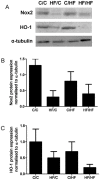Interaction between maternal and offspring diet to impair vascular function and oxidative balance in high fat fed male mice
- PMID: 23227196
- PMCID: PMC3515587
- DOI: 10.1371/journal.pone.0050671
Interaction between maternal and offspring diet to impair vascular function and oxidative balance in high fat fed male mice
Abstract
Aims: To determine the impact of maternal and post-weaning consumption of a high fat diet on endothelium-dependent vasorelaxation and redox regulation in adult male mouse offspring.
Methods: Female C57BL6J mice were fed an obesogenic high fat diet (HF, 45% kcal fat) or standard chow (C, 21% kcal fat) pre-conception and throughout pregnancy and lactation. Post-weaning, male offspring were continued on the same diet as their mothers or placed on the alternative diet to give 4 dietary groups (C/C, HF/C, C/HF and HF/HF) which were studied at 15 or 30 weeks of age.
Results: There were significant effects of maternal diet on offspring body weight (p<0.004), systolic blood pressure (p = 0.026) and endothelium-dependent relaxation to ACh (p = 0.004) and NO production (p = 0.005) measured in the femoral artery. With control for maternal diet there was also an effect of offspring post-weaning dietary fat to increase systolic blood pressure (p<0.0001) and reduce endothelium-dependent relaxation (p = 0.022) and ACh-mediated NO production (p = 0.007). There was also a significant impact of age (p<0.005). Redox balance was perturbed, with altered regulation of vascular enzymes involved in ROS/NO signalling.
Conclusions: Maternal consumption of a HF diet is associated with changes in vascular function and oxidative balance in the offspring of similar magnitude to those seen with consumption of a high fat diet post-weaning. Further, this disadvantageous vascular phenotype is exacerbated by age to influence the risk of developing obesity, raised blood pressure and endothelial dysfunction in adult life.
Conflict of interest statement
Figures









References
-
- Stamatakis E, Zaninotto P, Falaschetti E, Mindell J, Head J (2010) Time trends in childhood and adolescent obesity in England from 1995 to 2007 and projections of prevalence to 2015. J Epidemiol Community Health 64: 167–174. - PubMed
-
- Reilly JJ, Kelly J (2011) Long-term impact of overweight and obesity in childhood and adolescence on morbidity and premature mortality in adulthood: systematic review. Int J Obes (Lond) 35: 891–898. - PubMed
-
- Poston L, Harthoorn LF, van der Beek EM (2011) Obesity in pregnancy: implications for the mother and lifelong health of the child. A consensus statement. Pediatr Res 69: 175–180. - PubMed
-
- Frisbee JC (2005) Reduced nitric oxide bioavailability contributes to skeletal muscle microvessel rarefaction in the metabolic syndrome. Am J Physiol Regul Integr Comp Physiol 289: R307–R316. - PubMed
Publication types
MeSH terms
Substances
Grants and funding
LinkOut - more resources
Full Text Sources
Medical
Research Materials
Miscellaneous

